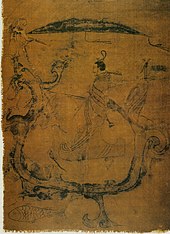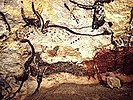The history of painting reaches back in time to artifacts and artwork created by pre-historic artists, and spans all cultures. It represents a continuous, though periodically disrupted, tradition from Antiquity. Across cultures, continents, and millennia, the history of painting consists of an ongoing river of creativity that continues into the 21st century.[1] Until the early 20th century it relied primarily on representational, religious and classical motifs, after which time more purely abstract and conceptual approaches gained favor.
Developments in Eastern painting historically parallel those in Western painting, in general, a few centuries earlier.[2] African art, Jewish art, Islamic art, Indonesian art, Indian art,[3] Chinese art, and Japanese art[4] each had significant influence on Western art, and vice versa.[5]
Initially serving utilitarian purpose, followed by imperial, private, civic, and religious patronage, Eastern and Western painting later found audiences in the aristocracy and the middle class. From the Modern era, the Middle Ages through the Renaissance painters worked for the church and a wealthy aristocracy.[6] Beginning with the Baroque era artists received private commissions from a more educated and prosperous middle class.[7] Finally in the West the idea of "art for art's sake"[8] began to find expression in the work of the Romantic painters like Francisco de Goya, John Constable, and J. M. W. Turner.[9] The 19th century saw the rise of the commercial art gallery, which provided patronage in the 20th century.[10]
Pre-history
[edit]The oldest known are more than 40,000-60,000 years old (art of the Upper Paleolithic) and found in the caves in the district of Maros (Sulawesi, Indonesia). The oldest are often constructed from hand stencils and simple geometric shapes.[11][a]

In November 2018, scientists reported the discovery of the then-oldest known figurative art painting, over 40,000 (perhaps as old as 52,000) years old, of an unknown animal, in the cave of Lubang Jeriji Saléh in the Indonesian island of Borneo.[13][14] In December 2019, cave paintings portraying pig hunting within the Maros-Pangkep karst region in Sulawesi were discovered to be even older, with an estimated age of at least 43,900 years. This finding was recognized as "the oldest known depiction of storytelling and the earliest instance of figurative art in human history."[15][16] In 2021, cave art of a pig found in Sulawesi, Indonesia, and dated to over 45,500 years ago, has been reported.[17][18] On July 3, 2024, the journal Nature published research findings indicating that the cave paintings which depict anthropomorphic figures interacting with a pig and measure 36 by 15 inches (91 by 38 cm) in Leang Karampuang are approximately 51,200 years old, establishing them as the oldest known paintings in the world.[19][20]
There are examples of cave paintings all over the world—in Indonesia, France, India, Spain, Southern Africa, China, Australia etc.
Various conjectures have been made as to the meaning these paintings had to the people that made them. Prehistoric artists may have painted animals to "catch" their soul or spirit in order to hunt them more easily or the paintings may represent an animistic vision and homage to surrounding nature. They may be the result of a basic need of expression that is innate to human beings, or they could have been for the transmission of practical information.
- Lascaux, Horse
- Lascaux, Bulls and Horses
- Spanish cave painting of Bulls
- Petroglyphs, from Sweden, Nordic Bronze Age (painted)
- Cueva de las Manos (Spanish for Cave of the Hands) in the Santa Cruz province in Argentina, c. 7300 BC
- Gwion Gwion rock paintings found in the north-west Kimberley region of Western Australia c. 15,000 BC[21]
In Paleolithic times, the representation of humans in cave paintings was rare. Mostly, animals were painted, not only animals that were used as food but also animals that represented strength like the rhinoceros or large Felidae, as in the Chauvet Cave. Signs like dots were sometimes drawn. Rare human representations include handprints and stencils, and figures depicting human / animal hybrids. The Chauvet Cave in the Ardèche Departments of France contains the most important preserved cave paintings of the Paleolithic era, painted around 31,000 BC. The Altamira cave paintings in Spain were done 14,000 to 12,000 BC and show, among others, bisons. The hall of bulls in Lascaux, Dordogne, France, is one of the best known cave paintings and dates to about 15,000 to 10,000 BC.
If there is meaning to the paintings, it remains unknown. The caves were not in an inhabited area, so they may have been used for seasonal rituals. The animals are accompanied by signs which suggest a possible magic use. Arrow-like symbols in Lascaux are sometimes interpreted as being used as calendars or almanacs, but the evidence remains inconclusive.[22] The most important work of the Mesolithic era were the marching warriors, a rock painting at Cingle de la Mola, Castellón, Spain dated to about 7000 to 4000 BC. The technique used was probably spitting or blowing the pigments onto the rock. The paintings are quite naturalistic, though stylized. The figures are not three-dimensional, even though they overlap.
The earliest known Indian paintings were the rock paintings of prehistoric times, the petroglyphs as found in places like the Rock Shelters of Bhimbetka, and some of them are older than 5500 BC. Such works continued and after several millennia, in the 7th century, carved pillars of Ajanta, Maharashtra state present a fine example of Indian paintings. The colors, mostly various shades of red and orange, were derived from minerals.
Eastern
[edit]
The history of Eastern painting includes a vast range of influences from various cultures and religions. Developments in Eastern painting historically parallel those in Western painting, in general a few centuries earlier.[2] African art, Jewish art, Islamic art, Indonesian art, Indian art,[23] Chinese art, Korean Art, and Japanese art[4] each had significant influence on Western art, and, vice versa.[5]
Chinese painting is one of the oldest continuous artistic traditions in the world. The earliest paintings were not representational but ornamental; they consisted of patterns or designs rather than pictures. Early pottery was painted with spirals, zigzags, dots, or animals. It was only during the Warring States period (403–221 B.C.) that artists began to represent the world around them. Japanese painting is one of the oldest and most highly refined of the Japanese arts, encompassing a wide variety of genre and styles. The history of Japanese painting is a long history of synthesis and competition between native Japanese aesthetics and adaptation of imported ideas. Korean painting, as an independent form, began around 108 B.C., around the fall of Gojoseon, making it one of the oldest in the world. The artwork of that time period evolved into the various styles that characterized the Three Kingdoms of Korea period, most notably the paintings and frescoes that adorn the tombs of Goguryeo's royalty. During the Three Kingdoms period and through the Goryeo dynasty, Korean painting was characterized primarily by a combination of Korean-style landscapes, facial features, Buddhist-centered themes, and an emphasis on celestial observation that was facilitated by the rapid development of Korean astronomy.












![Gwion Gwion rock paintings found in the north-west Kimberley region of Western Australia c. 15,000 BC[21]](https://upload.wikimedia.org/wikipedia/commons/thumb/4/43/Bradshaw_rock_paintings.jpg/140px-Bradshaw_rock_paintings.jpg)









